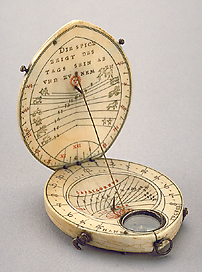
 |
| Catalogue |
 |
 Diptych Dial The stamped inscriptions are is filled with red, blue, brown and black colours. Two brass clasps allow the dial to be closed, another clasp attached to the opposite side would hold the dial in position while being used. The outer surface of the upper leaf contains a lunar volvelle for converting lunar into solar time. It consists of two circles and a movable brass disc with an index. The outer circle is marked with the age of the moon from 1 to 29, the inner circle with a 24-hour scale, numbered twice anticlockwise from 1 to 12. The brass disc also has a 24 hour scale, numbered in the same way. A circular outlet in the allows the phases of the moon to be seen. The inner surface of the upper leaf is marked for a vertical string gnomon dial, numbered in Roman numerals from VI to XII to VI, and a pin gnomon dial giving the length of the day in hours 8 to 16 according to the zodiacal signs, which are given as symbols. The pin is inset in the sun's effigy. The inner surface of the lower leaf is marked for a horizontal string gnomon dial, numbered 4 to 12 to 8, and a scaphe pin gnomon dial for Babylonian hours, numbered 1 to 16. The tropics are marked and the equinox is given as 'Libra'. The lower part of the scaphe is decorated with a stylized flower. Near the noon mark of the string gnomon dial is the date '1582'. To both sides of an inset compass with a deviation of circa 15? E is the signature of the maker 'HANS TVCHER'. The maker's mark, an upright crowned snake, is stamped in the compass well. The outer surface of the lower leaf has a gilt brass oval plaque decorated with a helmet and scrollwork. Surrounding the plaque is the inscription to be found on several dials made by the Tucher family: 'DER CAMPAST KAN NICHT RECHT WEISEN NAHET BEY EISSEN'. The instrument was presented by A.W. Franks and is described in F. A. B. Ward, A catalogue of European Scientific Instruments in the Department of Medieval and Later Antiquities of the British Museum (London, 1981), p. 38, no. 85. Silke Ackermann |



